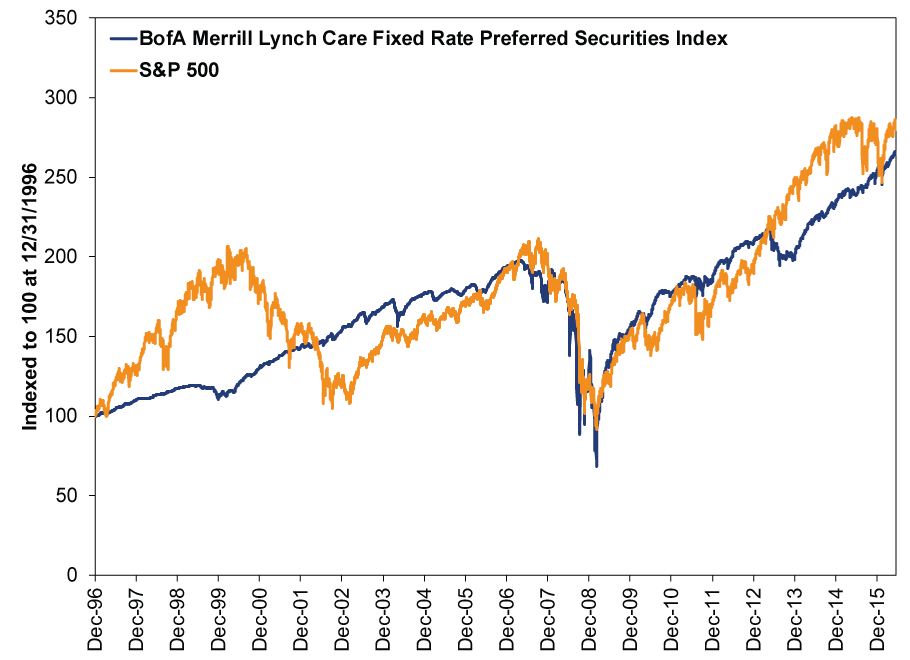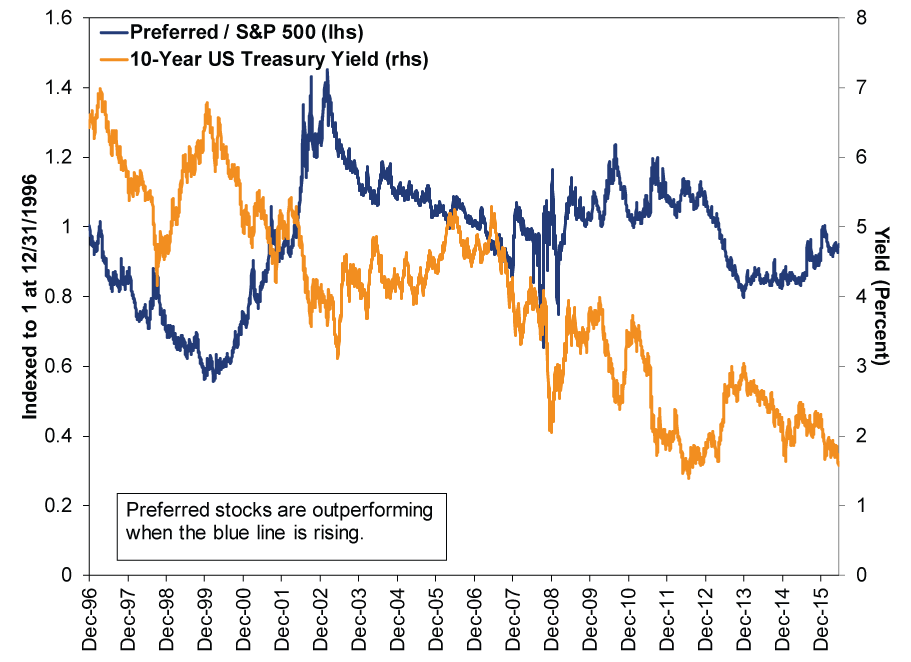Personal Wealth Management / Financial Planning
Why Preferred Stocks Quite Simply Aren’t
Preferred stocks are trendy right now, but they aren't viable bond alternatives.
Quick quiz, hotshot! What calls itself a stock, smells like a bond and is often peddled as "safe" high yield? That arcane little security known as the preferred stock, of course! With government bond yields retracing 2012 lows, preferred stocks have become some pundits' ... um ... preferred investment choice due to their high "fixed" dividends. (You will see shortly why we used scare quotes.) We aren't inherently anti- any security[i], but we think much of the recent commentary on preferreds encourages heat-chasing and glosses over the risks. Fact is, preferred stocks aren't inherently "safer" than common stock, and their widely heralded dividends come with some big asterisks. Look long and hard before you leap.
Preferred stocks are one of the quirkier investments out there. They are stocks-slices of ownership in a company-but unlike common stock, they lack voting rights. To make up for this, they're senior to common stock (hence the "preferred" moniker). Their dividends are paid before common stocks' dividends and generally less likely to be cut, though preferred dividend cuts and suspensions do happen. If the company goes bankrupt, preferred shareholders also have a greater claim on the assets and might get something out of the liquidation. For this reason, many consider preferred stocks as "safer" than common stocks, but they are no such thing. Preferred shareholders are junior to bondholders, so there is plenty of risk.
As compensation for that risk, many preferred stocks pay high fixed dividends, which sounds great, but "fixed" is relative. Like bonds, many preferred shares have pre-set maturities at issuance. However, if you buy a 20-year preferred stock with a 5% yield at issuance, you might not get that yield for 20 years. Unlike Treasury bonds, many preferred stocks are callable after a certain number of years, letting the issuer repurchase them at par value. If interest rates fall, the issuer has a big incentive to call the expensive preferred stock and replace it with something cheaper (read: lower-yielding).[ii] Bye-bye, happy yield. Hello, reinvestment risk: Where will you be able to replace that yield in the open market without taking undue risk?
Any security whose dividends, share price and future existence aren't carved in stone is not safe. It carries risk. Preferred stocks are subject to many of the same risks as bonds. Reinvestment risk, we just covered. There is also interest rate risk-as interest rates rise, lower-yielding preferreds become less valuable on the open market, so prices fall. Inflation is another risk. But preferred stocks aren't bonds. They're stocks, so they're also vulnerable to all the normal equity market risks. They got hammered in 2008 and have had plenty of pullbacks over the years. Over time, they have performed enough like common stocks that they are simply not a viable bond replacement. Yes, they have yields, but for many investors, bonds' primary role in a portfolio is to reduce expected short-term volatility. Preferred stocks don't do that anywhere near the extent bonds do. Moreover, while bonds aren't risk-free, governments are obligated to pay interest or face default. While we don't think it's wise to rely on yield alone for cash flow, at least you can more or less count on that yield being there. Not so with preferred stocks, which can cut or suspend dividends at any time. If you rely on a preferred dividend, and it gets cut, what then?
Exhibit 1: Common and Preferred Stocks

Source: FactSet, as of 6/20/2016. S&P 500 and BofA Merrill Lynch Core Fixed Rate Preferred Securities total return indexes, 12/31/1996 - 6/18/2016. Indexed to 100 at 12/31/1996.
Now, Exhibit 1 might make you ask, why don't I just ditch common stock for preferred and be done with it? Well, for one, as Exhibit 2 shows, loading up on preferred stock is basically a play on interest rates. Historically, preferreds have outperformed when rates fall and underperformed when rates rise. Long-term US Treasury yields, as mentioned earlier, are right near historic lows. They could fall further, as Germany and Japan have proven in recent years, but it seems an odd bet to make at a time when inflation is picking up and the economy is growing. We aren't saying yields soar from here, but the conditions don't seem right for yields to fall a lot and stay there. Piling into preferreds now reeks of heat-chasing.
Exhibit 2: Preferred Stock Is a Play on Falling Interest Rates

Source: FactSet, as of 6/20/2016. S&P 500 and BofA Merrill Lynch Core Fixed Rate Preferred Securities total return indexes (indexed to 1 at 12/31/1996) and benchmark US 10-Year Treasury yield, 12/31/1996 - 6/18/2016.
Sector weightings are another concern. Financials comprise about 66% of the preferred stock index used in these charts.[iii] In the S&P 500, Financials are just 15.8% of total market cap.[iv] If you were to, say, just buy a preferred stock index ETF and be done with it, you would have an astronomical Financials overweight. You would also have nearly three times as much in Utilities as the S&P 500, with only a smidge (about 1.4%) in Tech.[v] That is not a diversified portfolio. It is highly concentrated, with weird blind spots.
Again, we aren't inherently opposed to preferred stocks. We know Warren Buffett is a fan. But you are not Warren Buffett.[vi] You (probably) cannot ring up a company's board and ask them to issue a special class of preferred stock, just for you. You are you, and for most folks with relatively long time horizons and a need for growth and/or cash flow, we fail to see how heavy exposure to preferred stocks is worth the risk-particularly when you consider that preferred stocks have underperformed common stocks, on a total return basis, since the BofA Merrill Lynch index's inception. Instead of chasing yield, we think most folks are better off staying diversified, remembering bonds' primary purpose in their portfolio, and staying disciplined.
[i] Except variable annuities, non-traded REITs and non-traded Business Development Companies, all of which are better for the broker than the investor.
[ii] In this way, preferred shareholders' interests aren't totally aligned with the company's interests-calling preferred shares often benefits the company at the expense of the shareholder. Common stock doesn't have that conflict of interest.
[iii] Bank of America Merrill Lynch, as of 6/17/2016.
[iv] FactSet, as of 6/20/2016.
[v] Bank of America Merrill Lynch, as of 6/17/2016.
[vi] Unless you are, in which case, Hi Warren, hope you and Charlie are well.
If you would like to contact the editors responsible for this article, please message MarketMinder directly.
*The content contained in this article represents only the opinions and viewpoints of the Fisher Investments editorial staff.
Get a weekly roundup of our market insights
Sign up for our weekly e-mail newsletter.

You Imagine Your Future. We Help You Get There.
Are you ready to start your journey to a better financial future?

Where Might the Market Go Next?
Confidently tackle the market’s ups and downs with independent research and analysis that tells you where we think stocks are headed—and why.





